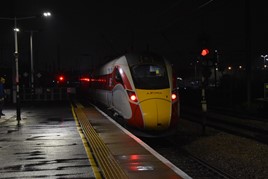
If you’re taking my grand rail tour of Switzerland part 2 Montreux to Champery https://traintraveloracle.com/switzerland-train-tour-part-two/– why not include Chamonix? Travelling on a Swiss Pass, also allows travel to Chamonix in France on the Mont Blanc Express. For an interesting side-trip between Champery and Zermatt, alight at Martigny station, midway between Aigle and Visp – all the trains stop there. After a short section along the Rhone valley, the cog train starts a steep climb up the mountain and through tunnels to the little village of Finhaut perched high above the Trient valley floor.
In summer, for the Emossen dam alight at Le Chatelard, the next station. From here take an amazing combination of a very steep funicular, miniature train and minifunic to the summit at 1925 metres.. Enjoy spectacular views of Mont Blanc and the Bouqui Gorge from the mighty Emossen dam. There’s an amazing 3 hour hike to Les Marecottes, steep but worth it. Or see the Dinosaur footprints at Vieux Emossen at 2400 metres. You can enjoy good food at 3 mountain restaurants. For further details visit https://verticalp-emosson.ch/fr/installations
For Chamonix change at Le Chatelard frontiere (not Le Chatelard town station). Year round, you can take the Montenvers cog railway from Chamonix station to the nearby glacier Mer de Glace. The 20 minute journey takes you to the hotel , where 100 years ago the glacier finished. Now you descend in a cable car and walk down 370 steep steps. Here, a huge cave has been excavated from the glacier snout with ice sculptures. There is also an exhibition on the effect of global warming is having on the glacier – its dramatic and real! For more info visit https://www.chamonix.net/english/leisure/sightseeing/mer-de-glace. Return by Mont Blanc express train to Martigny.
Martigny has an interesting cultural centre, the Pierre Gianadda foundation including the Gallo=Roman Museum with an archeological walk. The main exhibition features 19th and 20th century Swiss paintings and a photographic display of Swiss landscapes. In this little treasure house there is a collection of working vintage cars and a sculpture garden including works by Henry Moore. For more information see https://www.gianadda.ch/accueil/actualites/

How safe is Train travel during the Covid-19 pandemic?
Train travel in the UK is down by a much as 90%. Most train companies in the UK are running a skeleton service. Eurostar are only operating 2-3 trains a day to Paris and Brussels. The UK government warns against travel by public transport. Data from France from May to September 2020 they discovered that only 1.2% of Covid-19 infections came from public transport. In a recent RSSB study on a Hitachi series 800 the risk of infection of Covid 19 is 1 in 11 000. This is based on a carriage loading of 44 passengers. After 30.minutes 22 get off and a further 22 get on. Another 30 minutes later another 22 get off. And this figure does not allow for the use of face masks. As many trains are air conditioned, the air is circulated vertically further reducing the risk of infection by Covid 19. See https://www.railmagazine.com/news/network/1-in-11-000-chance-of-contracting-covid-19-on-trains for more details.
Perversely, the government is encouraging driving, which is many other ways is more dangerous than taking public transport. The effects of growing car use on Climate Change haven’t gone away. Ironically the greatly reduced numbers taking the train has made them even safer.
What do you think?
Why, despite the evidence, is the government encouraging car use over public transport?
The cost of subsidising the running of near empty trains is substantial, can this really be justified?
How can the rail industry persuade passengers to return to the trains?
